If you have customers, you need customer support software. It’s that simple. You can only juggle so many emails and social media mentions on your own before you miss an important email and leave a customer high and dry.
There will always be difficult questions to answer and dissatisfied customers to appease, but at least managing your support requests can be simplified. That’s where customer support and help desk apps come in.
Designed to make it easy for you to better support your customers, these apps bring emails, tweets, chat messages and more into a customer support command center. There, you can sort through the messages, assign them to the correct team member, and make sure everyone gets a reply. These apps also help you build a knowledge base full of help documentation so your customers can find quick answers to common questions.
Here are over 20 of the best customer service apps that keep your support ticket queue under control and your sanity intact.
The Top 7 Features of Customer Support Apps
How we evaluate and test apps
All of our best apps roundups are written by humans who’ve spent much of their careers using, testing, and writing about software. We spend dozens of hours researching and testing apps, using each app as it’s intended to be used and evaluating it against the criteria we set for the category. We’re never paid for placement in our articles from any app or for links to any site—we value the trust readers put in us to offer authentic evaluations of the categories and apps we review. For more details on our process, read the full rundown of how we select apps to feature on the Zapier blog.
If you sell products online, or have an email newsletter, you likely know your customers’ email addresses already. So, when looking for the best customer support app, prioritize its email tools. That’s what we did when evaluating apps for this roundup—we made sure they were great for answering emails.
But what else do you need? If you’re picking out your first app for customer support, the choices can be overwhelming. When making your decision, consider these seven most popular customer support tools: team inbox, knowledge base, forum, social, chat, phone, and mobile support.
1. Team Inbox

A support inbox with emails in Groove
You could set up a Gmail account for your company, and answer every email there. That’d quickly get difficult to manage, though. Either one person would have to answer every email, or you’d have to share the account password with every employee—not the most secure option. Worse still, it’d be hard to tell which emails need replies, and you might accidentally answer an email while a coworker is sending a separate reply.
A team inbox simplifies all that. That’s what most customer support apps are at their core: just a team inbox. All of your messages are delivered to one place, where each member of your team can log in and see the emails. Click a message, and you’ll see previous messages to quickly understand what’s going on. And if someone else is replying—or the ticket closes the moment you open it—most team inboxes show you who’s replying and whether or not the ticket is still open. If you’re stumped by an issue, these tools let you assign tickets to other team members, too.
Team inboxes also let you bring in emails from multiple addresses, so you can answer your support@yourcompany.com and billing@yourcompany.com questions together. And team inbox apps often include advanced features, like canned replies, keyboard shortcuts, and other tricks and tools to improve your response time. It’s an email inbox, designed to help you work more efficiently as a team.
2. Knowledge Base
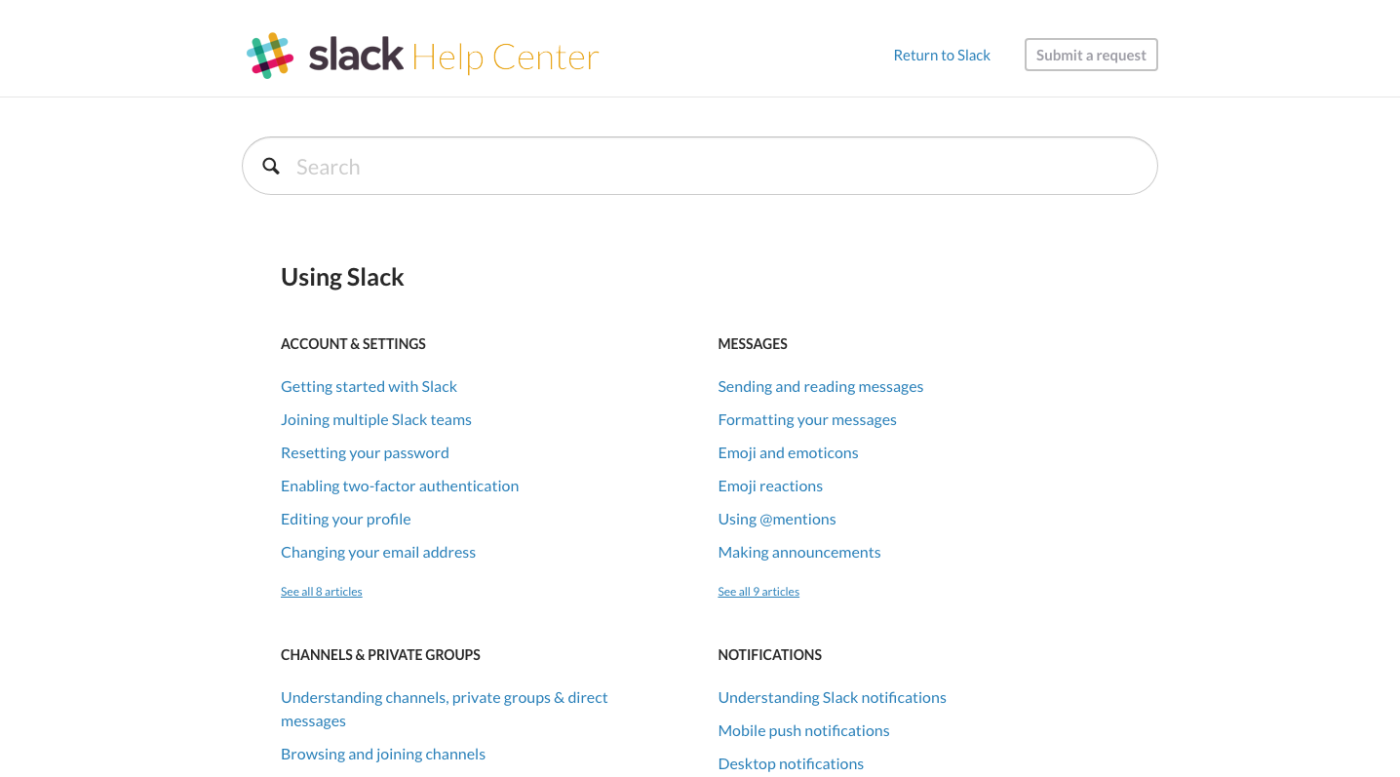
Slack relies on Zendesk for its knowledge base, the Slack Help Center
A knowledge base lets companies answer common questions before they’re asked.
Much like the Help menu in your favorite programs, a knowledge base is where you publish documentation about pricing, features, services, frequent problems, and anything else you want to share about your app or business.
The knowledge base then lets you easily share help documentation online, where your customers can search through them and then get in touch if they still need assistance. And once you’ve answered support emails for a while, you’ll be able to identify other common problems you should address in your documentation.
3. Forum

Disqus employs a support forum to let customers help one another.
You can also crowdsource support with a forum, creating a platform where your customers can help each other. Much like the comments section on a website, or a community discussion site like Reddit, a forum is where your customers post questions and start discussions with anyone else.
Instead of sending your team a private email, a forum encourages your customer to publicly post. Then you or your customers can publicly reply with ideas and tips, and your team can moderate discussion to make sure the advice accurate the comment is friendly. These answered questions live on in public, where others can find the solutions without reaching out to your team.
4. Social
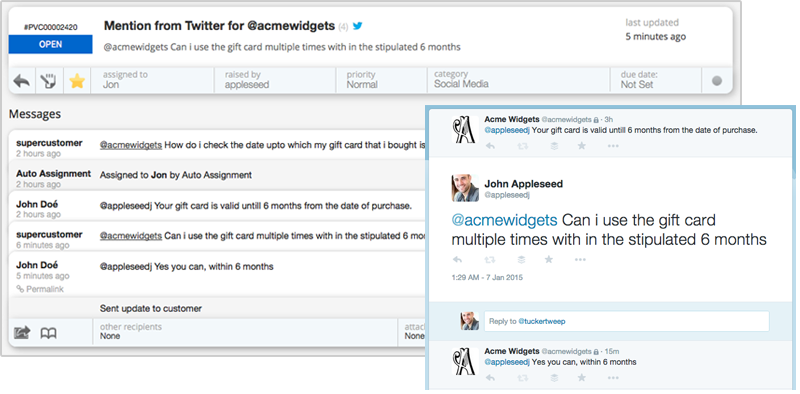
HappyFox pulls Twitter conversations into the team inbox.
When something is broken, the first action we take is to open Twitter or Facebook and either complain or ask for help. And when we love something new, we’re equally likely to share it online. That’s how your customers vent their frustrations and tell the world how much they like your company.
So join in. Support apps with social media integrations bring your Twitter mentions, Facebook messages and more right into your team inbox, so you can see those problems that otherwise might go unnoticed. Some even let you track keywords, so you can find people having trouble that perhaps forgot to mention your company by name.
5. Chat
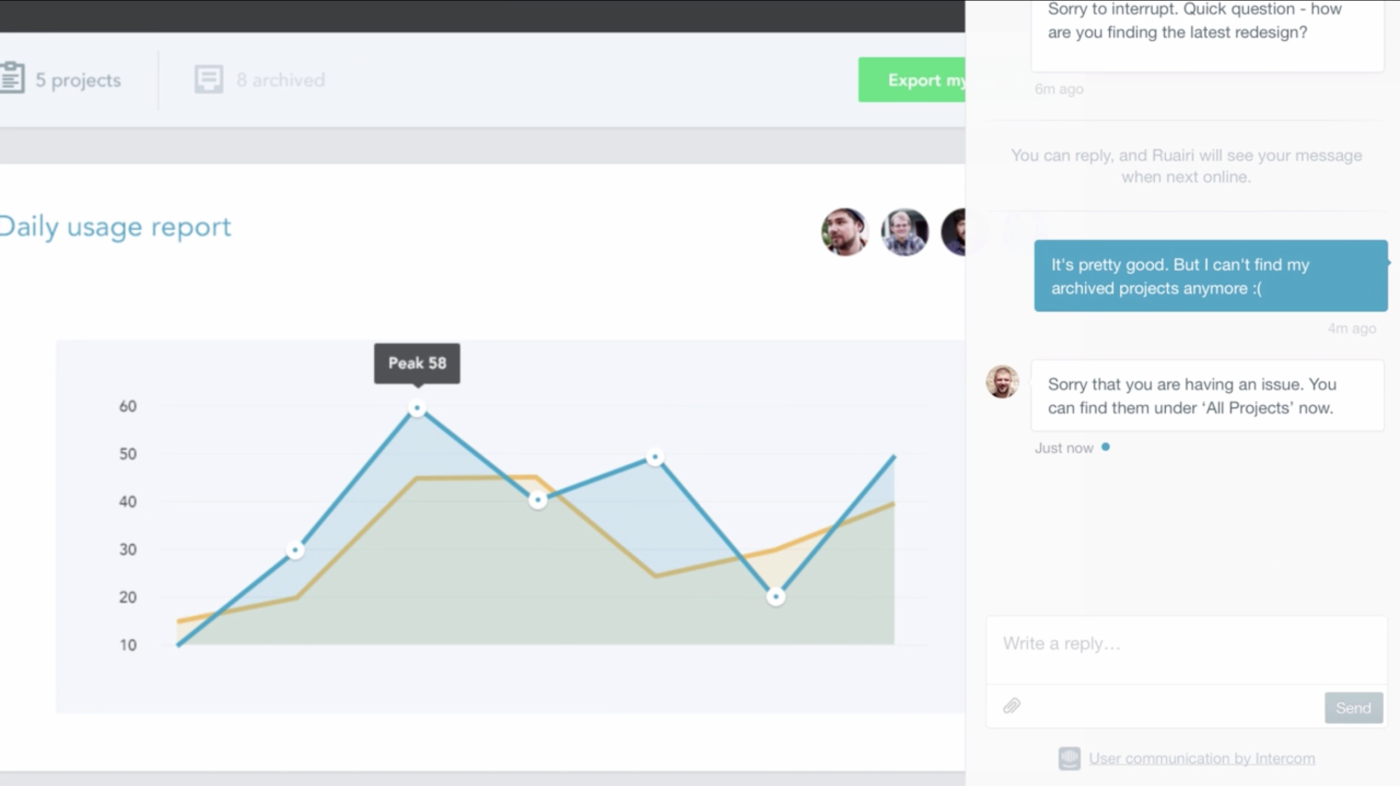
Intercom lets you interact with customers via email or live chat.
Email can be a great way to answer questions, but it can also take a long time to actually close a support ticket as you wait for your customer to reply. Live chat is a quicker way to solve problems and answer questions, and it’s often included as an extra tool in more advanced customer support apps. Add the app’s support widget to your site, and customers can chat with your team in real-time.
You can’t be online all the time, though, so most chat apps also let users send you an email if no one’s available to talk. Then, inside the team inbox, chats and emails show up together for a full look at your customer interactions.
6. Phone

Freshdesk includes phone support that turns calls into tickets
What’s even quicker than live chat? Phone calls. Like live chat, phone calls will take extra effort from your team: someone must be online and available whenever your customers have problems, and will need to figure out solutions on the fly. But calls can also let you dig deeper into issues, since you can ask questions and get detailed replies instantly.
Many customer support apps that help you offer phone support integrate with voice-over-internet tools like Twilio, while others include their own phone services or just let you log phone calls you have as a text support message. Either way, you’ll get a record of phone conversations alongside your other support requests.
7. Mobile App Support
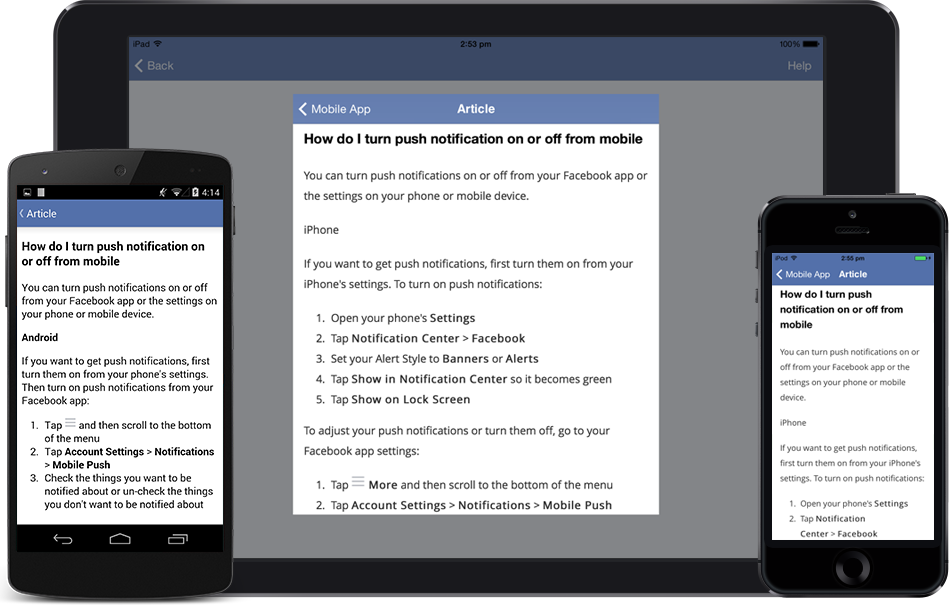
HappyFox helps you offer mobile support with its HelpStack feature
When something breaks, your customers want help ASAP—they don’t want to search for the correct form to fill out and get support. Mobile support tools include code to add your documentation, live chat, and email support inside your mobile apps, so assistance is only a Help button away.
Since the help tool is inside the app, it’ll be easier to help customers as most mobile support tools also capture info about the user’s device, what part of the app they were using, and more. Instead of asking extra questions and waiting for more information, your team will be able to solve problems with the first reply.
Support Ticket Systems vs Multi-Channel Support Apps
If you want to cover it all, you need a customer support app with everything: a team inbox, social media monitoring, a knowledge base and forum, and more. A tool that offers this suite of features is called a multi-channel support app. Or, perhaps you like to keep things simple, and only want a team inbox to answer emails and a knowledge base to let customers help themselves. If so, you’d opt for a support ticket system—it’s not full-featured, but what it does, it does well.
To help you find the ideal tool for your needs—a simple support ticket system or a robust multi-channel support app—we’ve examined the top customer service options. We broke down each app’s features and pricing structure and grabbed a screenshot to give you a quick view of how to answer emails in that app.
Without further ado, here’s an overview of the top 20 customer support apps—first, the simple support ticket systems, then the more feature-filled multi-channel support apps.
Support Ticket Systems
|
App |
Icon: |
Best for: |
Price |
Supports: |
|---|---|---|---|---|
|
Help Scout |
|
a cost efficient, easy-to-use help system |
Free for 3 users; from $20/mo. per user |
team inbox, knowledge base |
|
Groove |
|
simple support from your email inbox |
Free for 2 users; $15/mo. per user |
team inbox, knowledge base, social |
|
Front |
|
a team inbox for all your communications |
From $14/mo. per user |
team inbox, social, phone |
|
osTicket |
|
a self-hosted support system |
Free self-hosted; $9/mo. per user hosted |
team inbox, knowledge base |
|
Tender Support |
|
forum-style support |
From $9/mo. for 1 user; $20/mo. per extra user |
team inbox, knowledge base, forum |
|
SupportBee |
|
simple, full-team email support |
From $49/mo. for unlimited users |
team inbox |
|
Mojo Helpdesk |
|
timing replies and tracking happiness |
Free for 3 users; from $29/mo. for 10 users |
team inbox, knowledge base |
|
Sirportly |
|
real-language reports |
£14.99/mo. per user (around $23/mo.) |
team inbox, knowledge base, social |
|
Snappy |
|
a fast, Markdown-powered support inbox |
$15/mo. per user |
team inbox, knowledge base |
Multi-Channel Support Apps
|
App |
Icon: |
Best for: |
Price |
Supports: |
|---|---|---|---|---|
|
Zendesk |
|
support on any platform |
$1/mo. per user for 3 users; from $25/mo. per user |
team inbox, knowledge base, social, chat, phone, forum |
|
Zoho Desk |
|
a free support center |
Free for unlimited users; from $12/mo. per user for social and more |
team inbox, knowledge base, forum, social, phone, chat |
|
Freshdesk |
|
prioritized SLA support in your apps |
Free for unlimited users; from $25/mo. per user |
team inbox, knowledge base, social, chat, forum, mobile support |
|
UserVoice |
|
project management and support in one app |
From $15/mo. per user |
team inbox, knowledge base, mobile support, forum |
|
Desk |
|
Salesforce integration and tabbed interface |
$3/mo. for 3 users; from $30/mo. per user |
team inbox, knowledge base, social, chat, phone |
|
Intercom |
|
deeply filtering your communications |
From $49/mo. for unlimited users and 250 support contacts |
team inbox, knowledge base, social, chat |
|
Kayako |
|
support on all your devices |
From $29/mo. per user |
team inbox, knowledge base, chat, phone |
|
HappyFox |
|
tracking time spent on support tickets |
From $19/mo. per user |
team inbox, knowledge base, social, chat, phone, mobile support, forum |
|
LiveAgent |
|
a quick look at all interactions with a customer |
From $12/mo. per user |
team inbox, knowledge base, chat, social, forum |
|
Reamaze |
|
support inside your apps |
$20/mo. per user |
team inbox, knowledge base, chat, social, mobile support |
|
Deskero |
|
simple social support |
Free for 1 user; from $15/mo. per user |
team inbox, knowledge base, social, chat |
|
UserEcho |
|
learning from users |
$15/mo. per user |
team inbox, knowledge base, chat, social, forum |
The Best Ticket Support Systems
Would you prefer a simpler support tool, one that’s primarily focused on being a team inbox that makes it easy to respond to emails from your customers? These apps are the ones for you. They each include easy-to-use team inboxes that are focused on emails, typically along with a knowledge base tool to manage your documentation.
Then, if you want more—social network or chat app integration, perhaps—you can turn to their Zapier integrations to bring the messages you need into your team email inbox. It’s a great way to simplify your support, and get just the features you need.
Help Scout (team inbox, knowledge base)
for a cost efficient, easy-to-use help system

The majority of your support tickets are just emails, and Help Scout’s Gmail-style interface and keyboard shortcuts keep that in focus. You can have as many mailboxes as you need for support, each with their own email address, then Help Scout can further organize each mailbox into folders and categories based on rules.
Dive into an email, and you’ll see a familiar sidebar with information about the customer where Help Scout pulls in social media information and previous conversations to give your emails a personal touch. Help Scout also offers your customers a quick poll at the bottom of your emails to ask how well your team did at support, and you can see your team’s productivity and happiness scores along with other metrics inside Help Scout. It’s a simple, easy-to-use support tool, with the power you need to quickly answer questions without feeling overwhelmed.
Help Scout Price: Free for 3 users and 1 mailbox; from $20/month per user for full features
See Help Scout integrations on Zapier
Groove (email, knowledge base, social)
for simple support from your email inbox

A team inbox sounds like a great idea, but it’s still hard to not wish you could just answer all of your emails right from your personal email inbox. And you can. Groove gives you a full team inbox while still letting you work from your personal inbox if you’d like. New or assigned tickets can be auto-forwarded to your email account, where you can reply, re-assign the ticket, and change its status with simple commands at the bottom of your message.
Back on Groove, you’ll find a complete log of what everyone has accomplished, along with features like automation and saved common replies to speed up your work. There are also detailed reports in an easy to understand dashboard that’ll show your reply ratings, average replies and time spent, and more.
Groove Price: Free for 2 users and basic email features; $15/month per user Plus plan for full features
See Groove integrations on Zapier
Front (team inbox, social, phone)
for a team inbox for all your communications
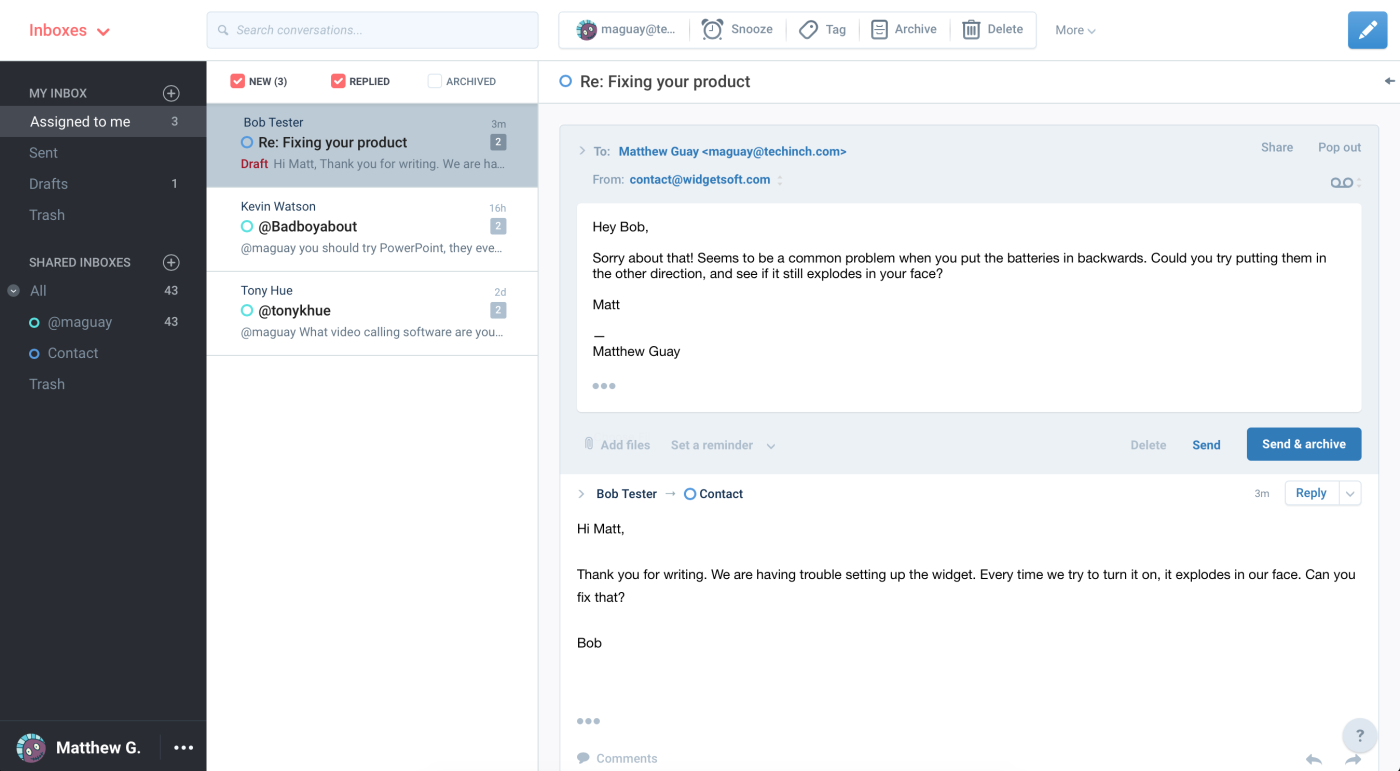
You already know how to use your email inbox, so Front designed its team inbox to work as much like popular email apps as possible. You can monitor any of your team’s email inboxes, with a three-column design that shows accounts, a list of messages, and the message you’ve selected in one view. You can assign emails, snooze a message until later, add tags to find emails in the future, and add a comment to get more information from colleagues. It’s not just for support—but it works great for support or anything else where you need to work on the same inbox with your teammates.
Front’s team inboxes can work for more than email, too. It includes built-in Twitter and Facebook integrations that allow users to view mentions and messages and then reply right from Front. Or, you can connect it to your Twilio, Truly, or Intercom to add an inbox for SMS messages, phone calls, and chat messages. Each one lives in its own inbox, with the familiar email-style interface, for a simple way to reply to all of your messages in one app.
Front Price: from $14/month per user Team plan for 5 inboxes, canned responses, plugins, and automated rules
Zapier integration with Front coming soon
osTicket (team inbox, knowledge base)
for a self-hosted support system

Want a free support tool that can run on your own servers? osTicket is the app for you. It’s an open source support tool that includes everything—you can answer support emails, assign tickets to other team members, create support forms, and write your help documentation all on your own server, for free. You can even tweak osTicket, by digging into its code or installing language packs and add-ons to employ extra features. And, you can set it up to send emails through a transactional email service to make sure your emails always get delivered.
osTicket includes some extra features, too. It locks tickets while you’re replying, so no one else can accidentally reply to the email at the same time. It also includes a tasks tool to let you create to-dos for others and make sure they don’t forget to reply to important messages. With these features and more, osTicket might be a great option for you even if you weren’t considering hosting your own support app.
osTicket Price: Free open source edition to run on your own servers; from $9/month per user hosted edition
You can use Zapier’s MySQL Integrations to connect osTicket to your other apps
Another popular free self-hosted support system is HESK, which also includes IT asset management for a one-time fee.
Tender Support (team inbox, knowledge base, forum)
for forum-style support

Answering the same questions over and over gets tiring, and takes up time you could spend answering new questions or building your product. Tender Support simplifies things by defaulting to community forums, and treating your public and private messages the same. Whenever someone has a question about your product, Tender’s help form defaults to having them ask a public question. Once you answer it, any other customer can see the response and solve the problem without having to open a new support ticket.
Some questions still require a private message, so your support page will include an option to send the message in this manner. Tender then automatically looks through your documentation and emails your customer a link to something that might answer their question. You can still answer on your own, but you’ll likely have far fewer issues you’ll have to solve.
Tender Support Price: From $9/month Starter plan for basic support and 1 user; $20/month for each additional user.
See on Zapier
SupportBee (team inbox)
for simple, full-team email support
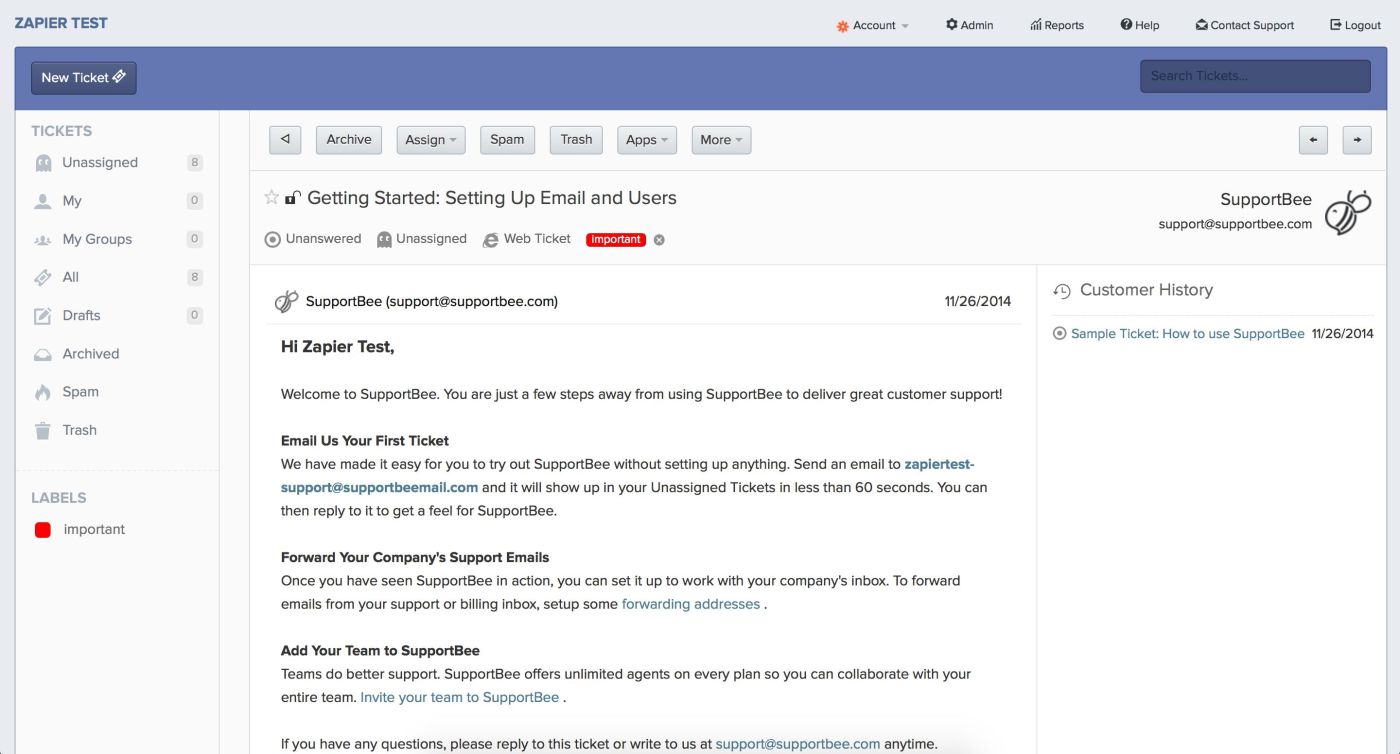
Most support apps charge per users, making it tough to decide how many people should help with support tickets. SupportBee simplifies things by charging a flat rate, no matter how many people are helping juggle support tickets. It’s an email-focused support app—without a help center—that gives you a centralized inbox for every email your team needs to handle. New emails flow into your inbox and refresh automatically, so you’ll always be on top of the freshest tickets.
SupportBee is designed like an email app, with labels, HTML email rendering, and Gmail-style shortcuts. You can save snippets of text to quickly fill out important parts of email replies, mixing and matching snippets for each part of your reply instead of relying on full canned replies. With simple filtering to send tickets to the right team member, and SupportBee automatically suggesting snippets to use based on tags, you’ll answer support tickets faster than ever.
SupportBee Price: From $49/month Startup plan for unlimited users and up to 1,000 tickets
See SupportBee integrations on Zapier
Mojo Helpdesk (team inbox, knowledge base)
for timing replies and tracking happiness
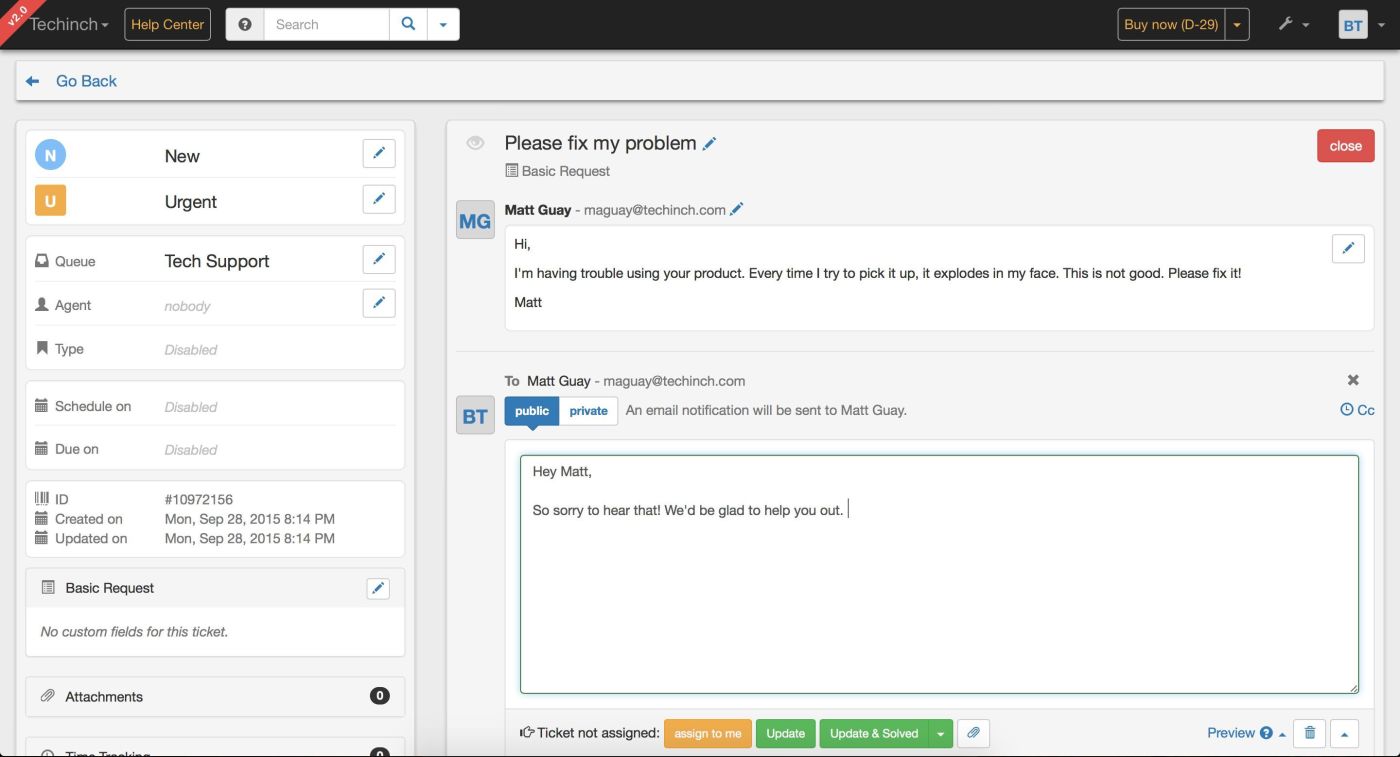
Your customers’ happiness with your support team is likely linked to how fast you reply—and if you really solve their problems. Mojo Helpdesk includes a number of features to help you solve every issue on time. You can customize your support form to make sure you gather enough information about each problem to solve it on your first try. Then, there’s built-in service level agreement (SLA) agreements, to help make sure you answer your support tickets as quickly as you’ve promised.
Timeliness goes beyond clearing the inbox—you’ll also want to make sure you’re getting faster at solving problems. Mojo Helpdesk includes a time tracking tool, so you can see how long each ticket takes and how much you’ve improved. It’ll even notice when you step away, pausing the timer and refreshing the inbox when you get back. Your customers can share their thoughts on your timeliness, as well, clicking a button at the bottom of your emails to let you know if they’re satisfied or not.
Mojo Helpdesk Price: Free for up to 3 users; from $29/month Professional plan for 10 users with email support and knowledge base; $399/month unlimited plan available
See Mojo Helpdesk integrations on Zapier
Sirportly (team inbox, knowledge base, social)
for real-language reports

It’s one thing to see a graph of your support traffic, but quite another to quickly find out that you’ve had 100 more emails today than on average. Sirportly makes it simple to find quick facts about your support queue, with its simple, real-language reports that tell “44 tickets were received today (that’s 4 more than normal)”, perhaps, instead of showing only a graph of your stats. You’ll know at a glance how fast your team’s responding, and who’s sending in the most questions today—or you can build custom queries to find out anything else you want.
Sirportly also makes it easy to manage all of your support, no matter how many different companies, teams, or products you need to support. You can add all of them to your account, separate support inboxes for different teams and needs, and use workflows to route tickets and automatically follow-up to help keep your support queue in check. It can even pull in customer data from your app, to make sure you’ll have the information you need to solve customer problems. Or, if you want, you can run Sirportly Enterprise on your own servers to keep your app and support in one place.
Sirportly Price: £14.99/month per user for full features (around $23/month)
Snappy (team inbox, knowledge base)
for a fast, Markdown-powered support inbox
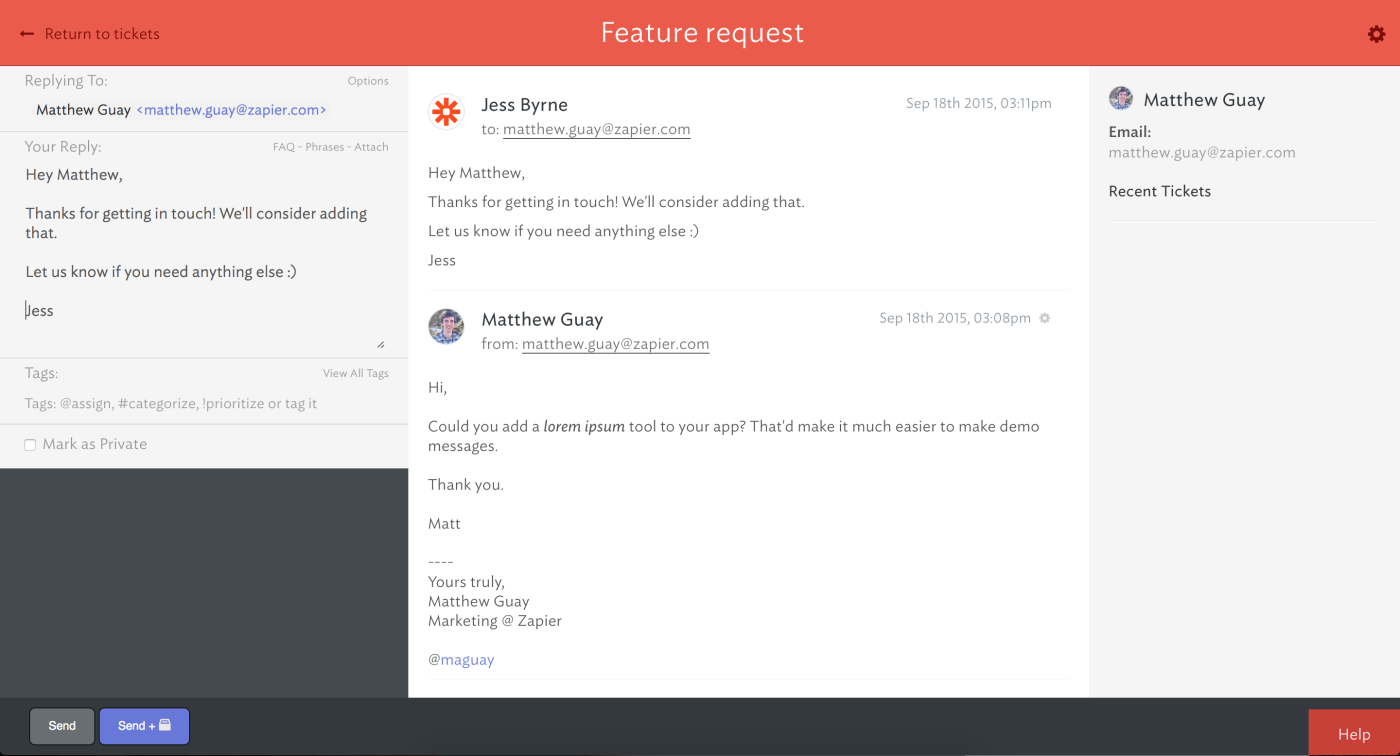
It’s easy for support apps to become bloated with tools for a dozen different support-related tasks—but what if you want just a simple way to answer your customer’s questions? Snappy offers that with an impressively fast app that’s focused on emails, FAQs, and nothing else. You’ll start out at its dashboard, which shows a large preview of messages and the time since they were received—a reminder of how long your customers have been waiting. You can send a quick, Markdown-formatted reply there, or open the message for a full look at their email, previous requests, and more.
Finding the right email to focus on is simple with Snappy’s Lenses features, which are filters that help you find emails about specific topics, emails assigned to someone in particular, or customers have for too long been awaiting a reply. You can then make an easy-to-understand support center with Snappy’s FAQs, which require you to think of everything as a question. And as you’re working, you can let your team know your status on the Wall, an internal social network just for your support team.
Snappy Price: $15/month per user for full features
See Snappy integrations on Zapier
Another promising simple support tool is the currently-in-beta SupportYard. It brings your team messages together in a simple interface, with search and tags to help you find the messages you need.
The Best Multi-Channel Support Apps
Looking for a full-featured support app—one that can manage your support emails, social networking mentions, phone calls or text messages? Each of these apps goes far beyond the basics of handling support. They’re a bit more complicated and might take longer to get started using, but they also help manage every possible aspect of support you ever need—and more.
Zendesk (team inbox, knowledge base, social, chat, phone, forum)
for support on any platform

Today you need to offer support via email, Twitter, Facebook, and perhaps phone. Tomorrow, who knows which new social networks and communications tools will be most popular? Zendesk is ready either way. It’s designed to enable you to help your customers wherever they are, with support for tools to add chat, SMS, and much more—along with CRMs, forms, and other tools that can add extra data to your support tickets. If you ever need additional features, you can build your own Zendesk App or check back for a new one from their team.
Zendesk is also designed to help calm your support queues by letting customers help themselves. When someone wants to ask your team a question, they’ll first be shown your documentation, where Zendesk will show articles that might answer their questions. Only then will they be able to send you a message, helpfully cutting down on repetitive questions you’d otherwise have to field. They’ll also be able to help you know how well your support is doing, through a Net Promoter Score survey at the bottom of your messages.
Zendesk Price: $1/month per user Starter plan for up to 3 users; from $25/month per user Regular plan for satisfaction surveys and communities
See Zendesk integrations on Zapier
Zoho Desk (team inbox, knowledge base, forum, social, phone, chat)
for a free support center

Editor’s note: Zoho Desk was formerly called Zoho Support.
Zoho makes apps for everything: office files, CRM, accounting, and much more. Zoho Desk follows in the grand tradition of the other Zoho apps, with a similar interface, one account that works with all of the Zoho apps, and tight integration with the other Zoho tools. And, most incredibly, it lets you build a full support center for free.
Just by signing in with a Zoho account, you can set up a support center with email, documentation, and a user forum, and bring in as many of your teammates as you need to manage support. Then, if you want to add a social network integration, chat, phone support, or tie in Zoho CRM, you can upgrade to a paid account. It’s one of the cheapest ways to get your support center off the ground, without leaving behind any of the features you’d expect from a multi-channel support app.
Zoho Desk Price: Free for unlimited users for email and support forum; from $12/month per user Professional plan for social and phone support, and Zoho CRM integration
Freshdesk (team inbox, knowledge base, social, chat, forum, mobile support)
for prioritized SLA support in your apps
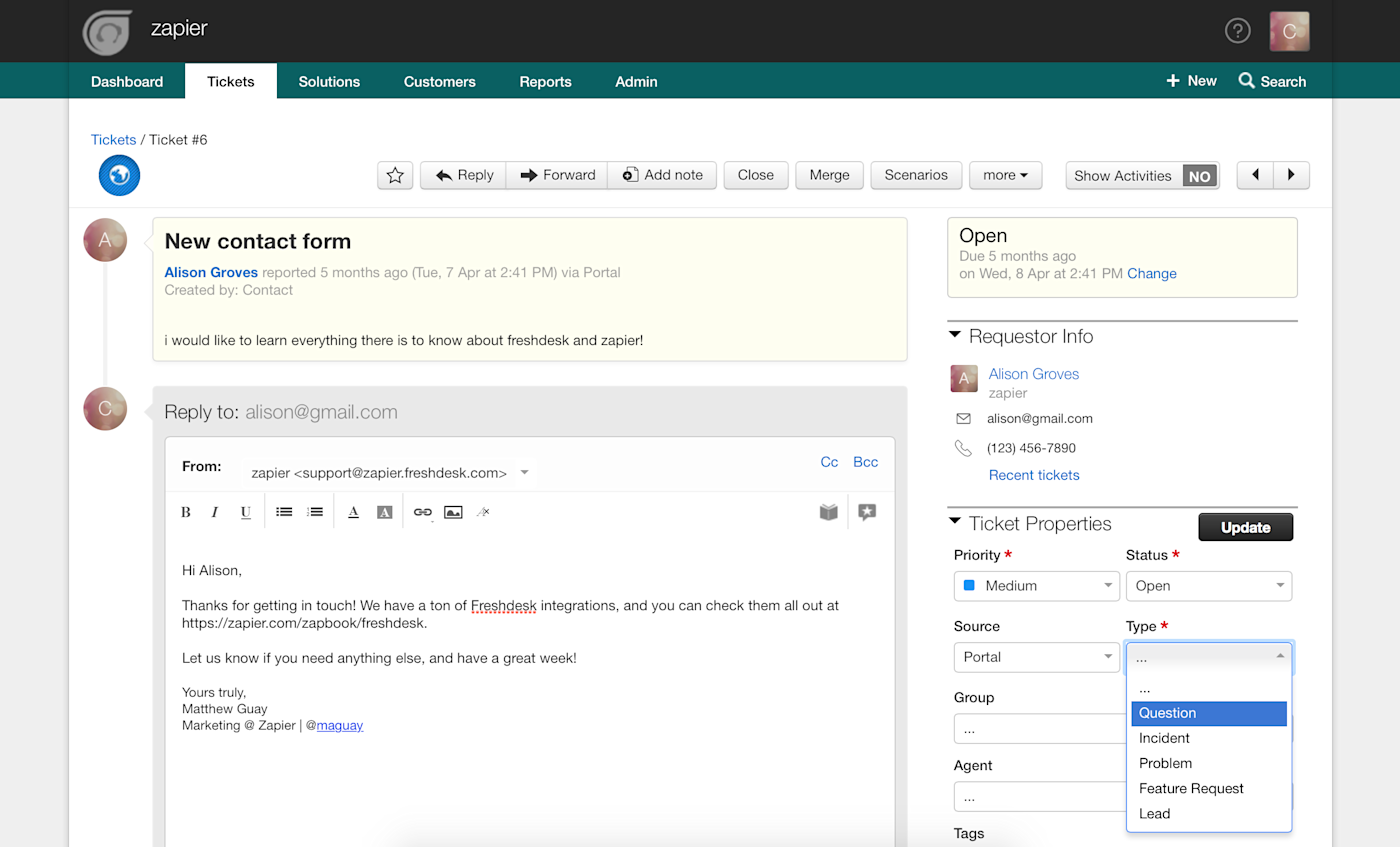
Figuring out where to focus your support attention is difficult. Should you answer the emails that just came in, reply to a Tweet from last night, or see if any Facebook messages came in? Freshdesk makes it easy to decide, with built-in service level agreement (SLA) policies that make sure you prioritize support the way you intend. Indicate which support channels or user levels should get the fastest support, and Freshdesk marks tickets as increasingly important based on how long they’ve waited.
When your customer receives your reply, it will be in the format they expect. Instead of turning everything into an email message, Freshdesk lets you record phone calls, reply to Facebook messages directly in a dedicated tab on your Facebook page, and push notifications to your mobile app users when you respond. You can even offer real-time support with Freshdesk’s live chat widget on your site.
Freshdesk Price: Free for unlimited users with core features; from $25/month per user Blossom plan for social channels, satisfaction surveys, custom domains, and time tracking
See Freshdesk integrations on Zapier
UserVoice (team inbox, knowledge base, mobile support, forum)
for project management and support in one app
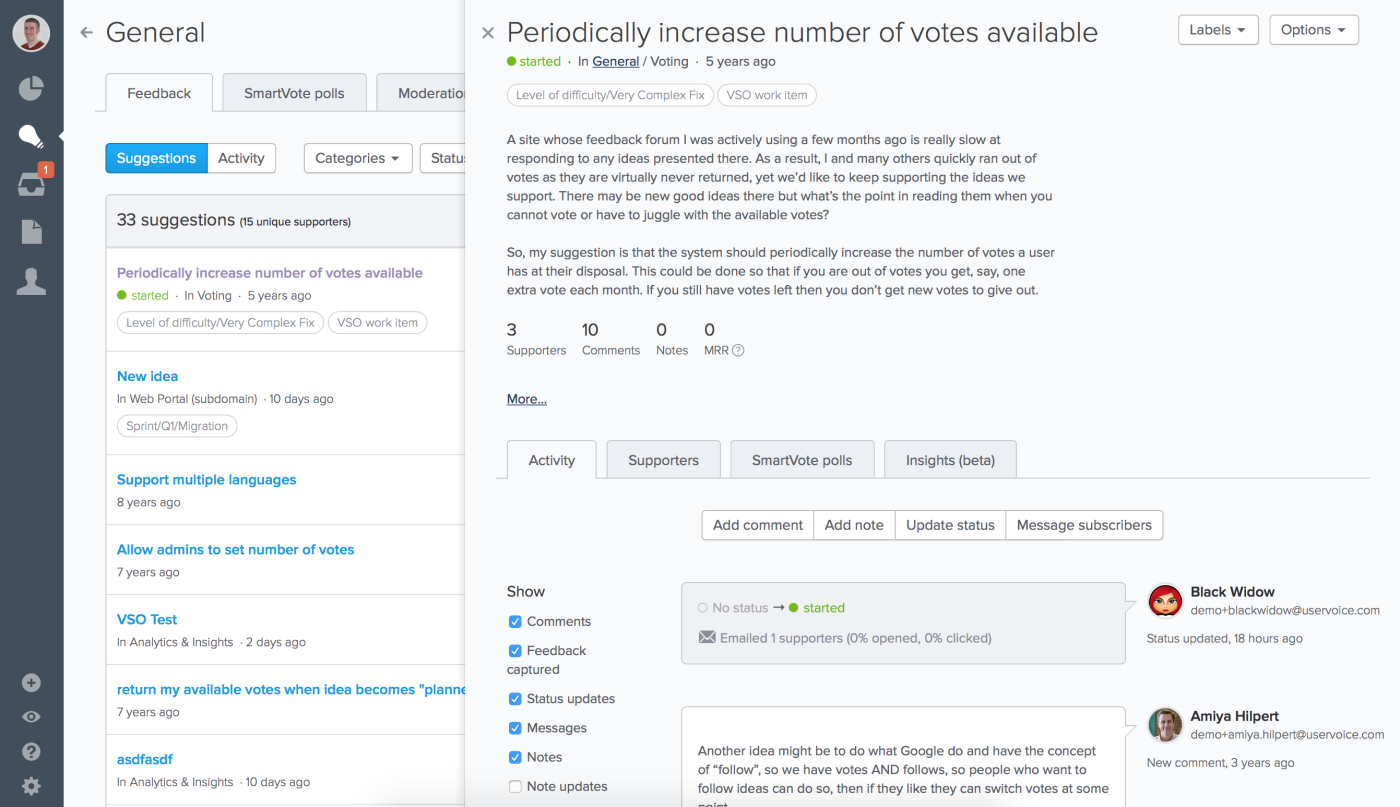
It started out as a tool for customers to request and vote on new features and improvements in their favorite products. Then it added customer support tools, so you can solve your users’ problems and listen to their ideas in one place. Today, UserVoice combines project management, customer support, and a forum all in one app, so you can use feedback to direct your development.
Customers can send in new public ideas or private messages, and your team can answer them all from one combined dashboard. There’s even integrations with internet phone systems, CRMs, social networks and more to get as many of your support requests in one place as possible. UserVoice watches everything going on and combines it with your public feature requests to build a project management queue for your team. You’ll know exactly what to work on next—and how valuable it will be to your users—with UserVoice’s support data-based project management.
UserVoice Price: From $15/month per user Standard plan for core support features; from $499/month Basic plan for project management features.
See UserVoice integrations on Zapier
Desk (team inbox, knowledge base, social, chat, phone)
for Salesforce integration and tabbed interface
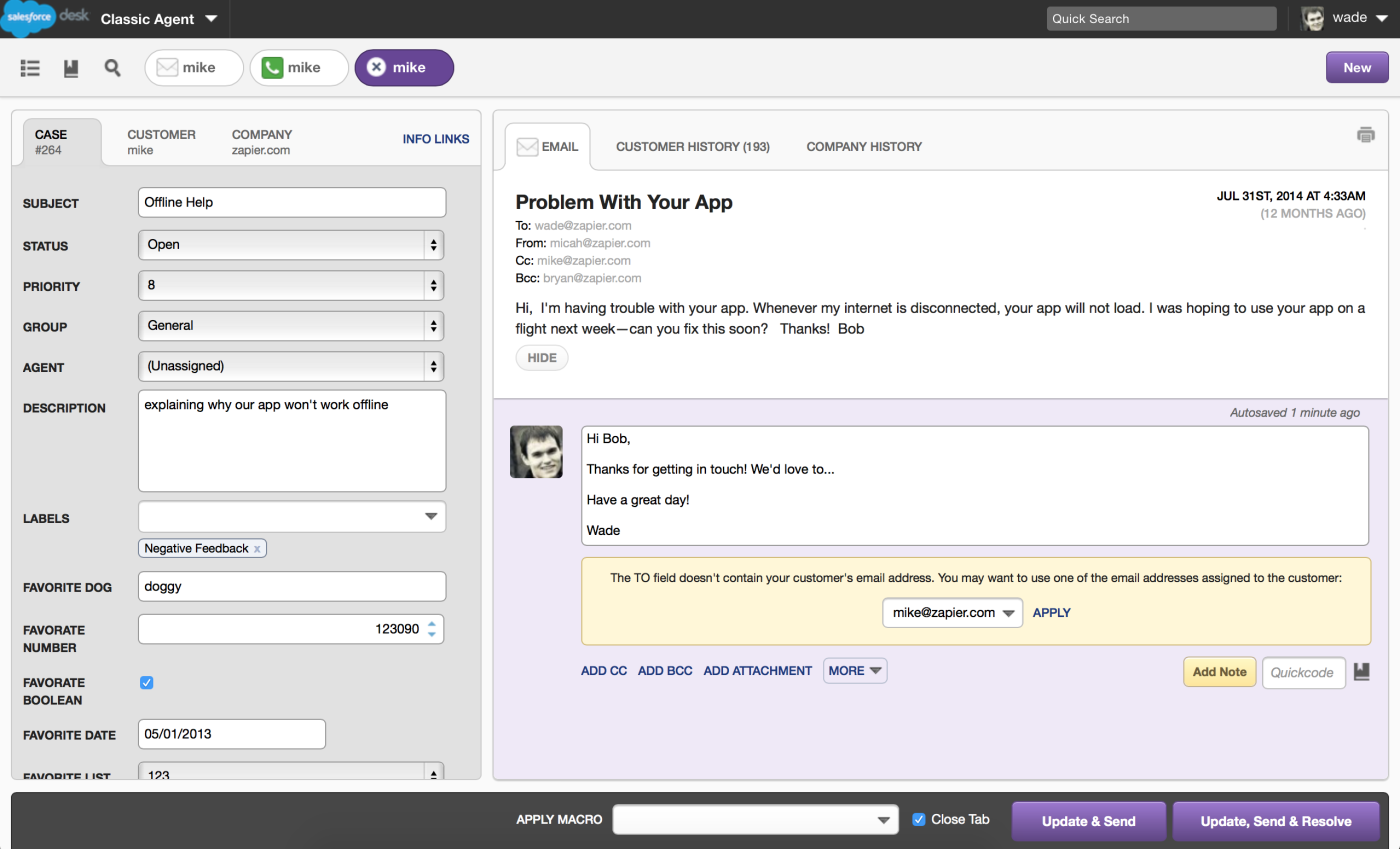
Ever need to switch between emails as you work out a solution—perhaps answering a simpler question while thinking over a hard one, or working on multiple similar tickets at the same time? Desk’s tabbed interface would be perfect for you. Open all the tickets you want to answer from the dashboard, then flip between each of them in tabs. It’s a quicker way to work on a short list of tickets.
Desk also makes sure you have the data you need at hand to help your customers out. As part of the Salesforce family of apps, Desk shows your CRM data alongside tickets if you’re a Salesforce user, and it logs support questions back to a contact’s profile in your CRM. You can also tap Salesforce’s reporting tools in Desk, allowing you to visualize your team’s performance and find areas to improve.
Desk Price: $3/month Starter plan for 3 users; from $30/month per user Standard plan for basic support and knowledge base features
See Desk integrations on Zapier
Intercom (team inbox, chat, social, chat)
for deeply filtering your communications
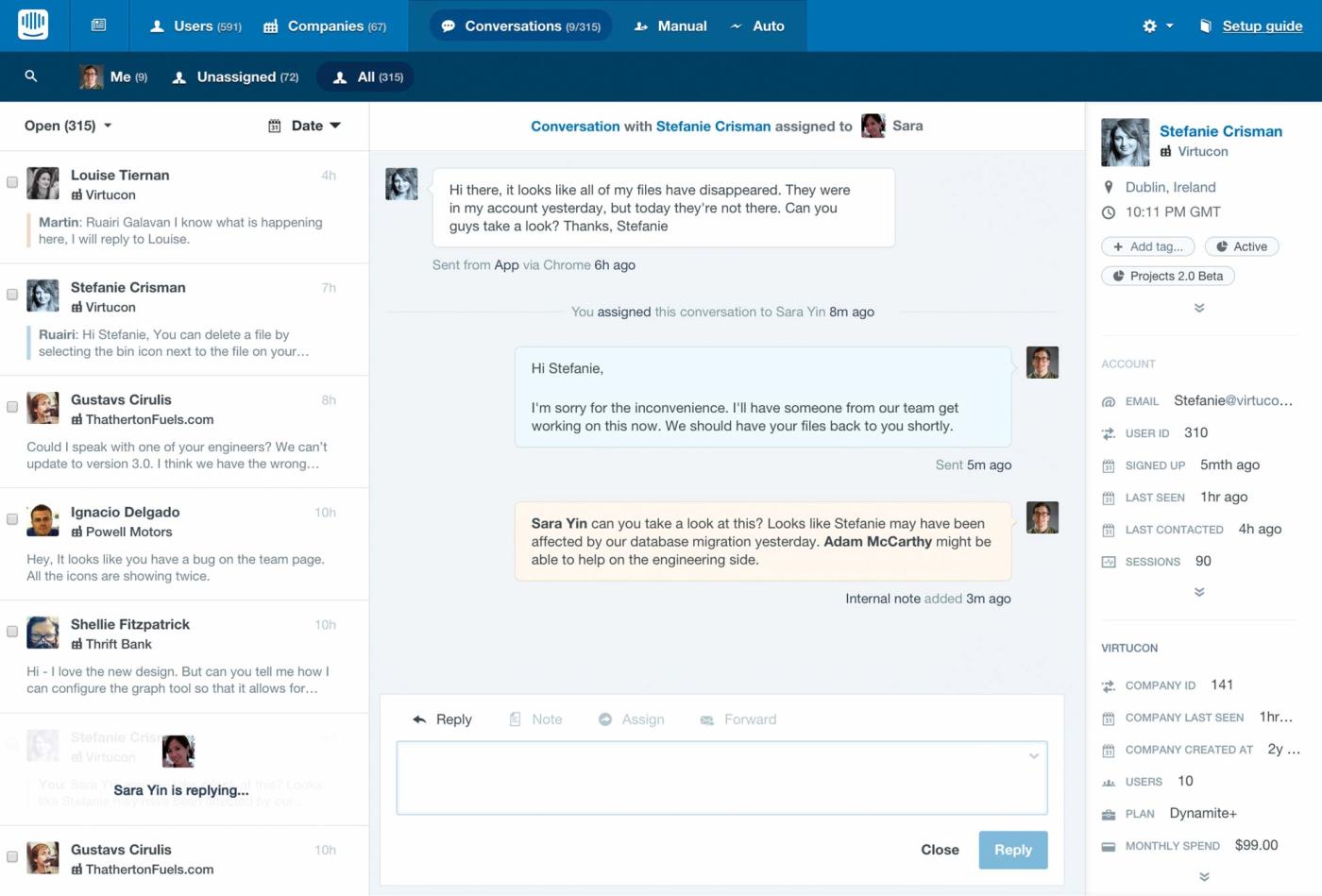
Want to find support tickets from users who’ve purchased your product more than a year ago, and also used your trial before purchasing? A simple search won’t cut it, but Intercom’s detailed filters and customer profiles make it easy to find any ticket you want.
Intercom watches your customers’ interactions on your site and keeps track the pages they visit, when they started a trial, looked at a pricing page, or anything else. You can then reach out to customers with messages inside your app, chat with users to answer their questions before they make a purchase, then reply to their support emails later on—all from the same app.
Intercom’s support interface lets you jump between emails quickly, and reply in short, chat-style messages. On the right, you’ll see the contact’s full profile—including the last time they visited your site, the number of times they’ve used your app, and more. You can even integrate your support center into your mobile app with Intercom’s iOS and Android code, and respond directly in your app—even while you’re on the go. And at the same time, Intercom can send automated emails and other marketing messages to keep customers engaged and offer proactive support or tutorials.
Intercom Price: Free to observe visitors on your site; From $49/month Support plan for unlimited users and up to 250 support contacts
See Intercom integrations on Zapier
Looking for another customer support tool that either doubles as a CRM or has CRM features like Intercom? Interakt is a great option for an email marketing-focused CRM that also handles customer support. Streak, a CRM built inside Gmail, is another support and CRM tool. And even Salesforce includes a Service Cloud tool to answer support tickets inside its popular CRM.
Kayako (team inbox, knowledge base, chat, phone)
for support on all your devices
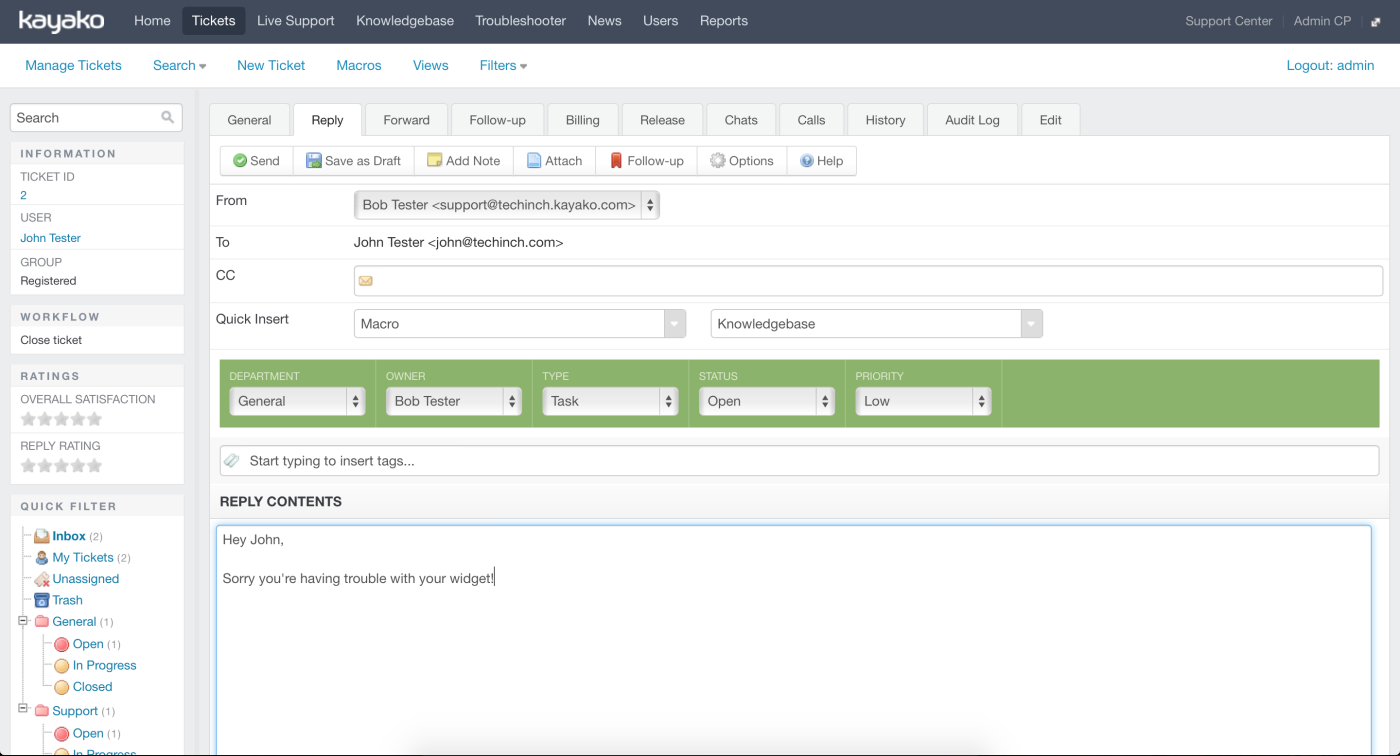
Web apps are great—they work on almost any browser, and don’t require any installation or downloads. But sometimes, it’s nice to have an app designed for your computer, and Kayako offers that for almost every device. It includes mobile apps for iOS, Android, Windows Phone, and Blackberry, along with desktop app for Windows PCs and Macs. You can answer support emails from the web and mobile apps, then take calls and field live chats from the desktop apps to make sure you never miss anything.
Kayako also includes an advanced support center that helps your customers solve more of their problems on their own. You can include documentation articles, tutorials, troubleshooting guides, and news all in your knowledge base. Whenever someone has a problem, Kayako searches through all of that before letting them send an email. Then, it pulls all of a customer’s chats, emails, billing, logs and more together whenever they get in touch, so you’ll know exactly how to solve their problems.
Kayako Price: $29/month per user Case plan for email and basic features; from $49/month per user for live chat and calls
HappyFox (team inbox, knowledge base, social, chat, phone, mobile support, forum)
for tracking time spent on support tickets
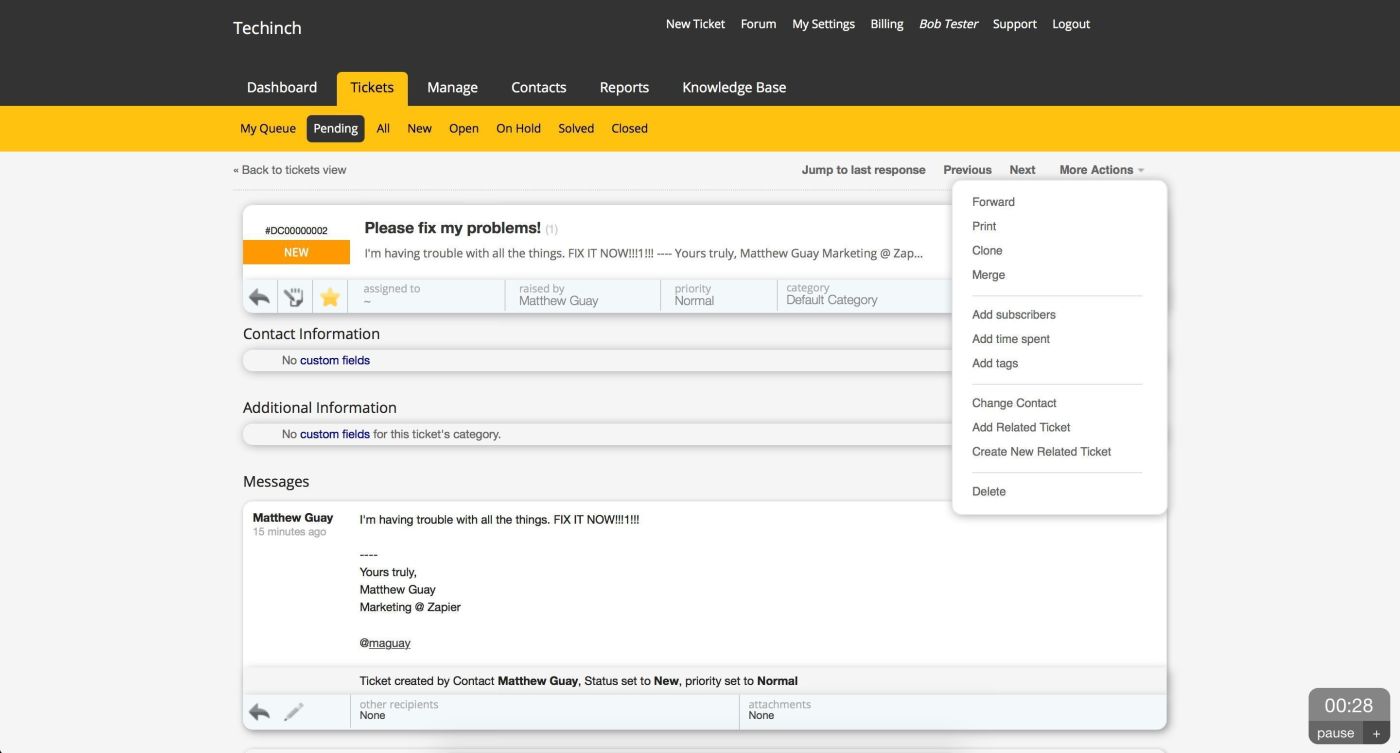
Wonder how much time your most difficult support tickets take to answer? Wonder no more. HappyFox include a time tracking tool right inside its team inbox, to see how long it takes to answer each email. You can then bill clients for priority support, or adjust your team’s goals based on the tracked time. Simpler tickets can be cleared out right from your support dashboard, without having to open a new page.
HappyFox also takes away another bit of guesswork you’d have with most support centers: how to migrate your data. It can import existing support tickets from Zendesk and Desk, and its reports let you export your HappyFox contacts, tickets and more in spreadsheet formats. Its mobile framework even accommodates other customer support apps, to keep you from feeling locked-in.
HappyFox Price: From $19/month per user Popular plan for basic support features and up to 10 categories; $39/month per user for Mighty Plan with time tracking.
See HappyFox integrations on Zapier
LiveAgent (team inbox, knowledge base, chat, social, forum)
for a quick look at all interactions with a customer
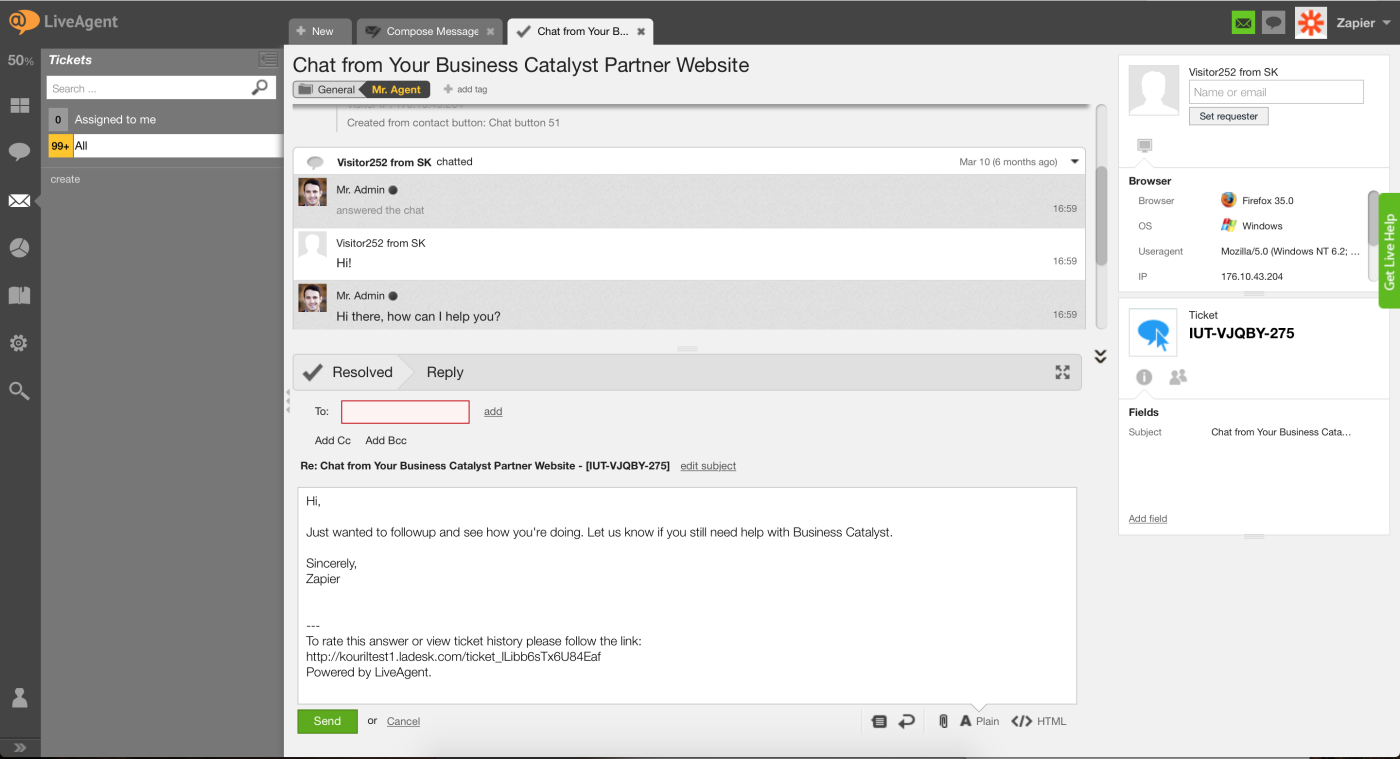
Answering support tickets well without knowing the full context is difficult at best. Something that seems to be a difficult question might be much easier to solve if you saw the customer’s previous interactions with rest of your team. LiveAgent makes this simple by pulling ever interaction your team has with a customer into a continuous, chat-like thread. You’ll see their previous emails, chat sessions, and more—everything they’ve ever talked about with your team will be right there, to make solving today’s issue easier.
LiveAgent is focused on real-time support, with a live chat widget for your site and SLAs to ensure you provide on-time support to your best customers. But it also can help your team from burning out, by letting each support team member set their own schedule and keep new tickets from coming into their queue while out of office. With each interaction in one place, it’ll be easier for others to pick up where you’ve left off, so you can step away and then jump back in ready to tackle brand-new tickets without leaving anyone waiting.
LiveAgent Price: From $12/month per user Ticket plan with email support; from $29/month per user for live chat support
See LiveAgent integrations on Zapier
Reamaze (team inbox, knowledge base, chat, social, mobile support)
for support inside your apps

Email doesn’t have to be the quickest way for your customers to get their problems solved—Reamaze can help them get answers right inside your app. Build your help docs in Reamaze, then embed them into your website or app, right along with Reamaze’s chat widget. Whenever your customer gets in touch, you can see their account inside your app, and know exactly what they’ve purchased or the problems they’ve had in the past. You can then help them with their orders and more, without ever having to ask for extra info.
Reamaze also lets you monitor an email address or social accounts for help messages, and brings everything together for you to answer in one place. But with your help built so deeply into your app, you’ll be more likely to get all the support tickets right inside your app anyhow.
Reamaze Price: $20/month per user for core features; additional $5/month per user for live chat support
See Reamaze integrations on Zapier
Deskero (team inbox, knowledge base, social, chat)
for simple social support
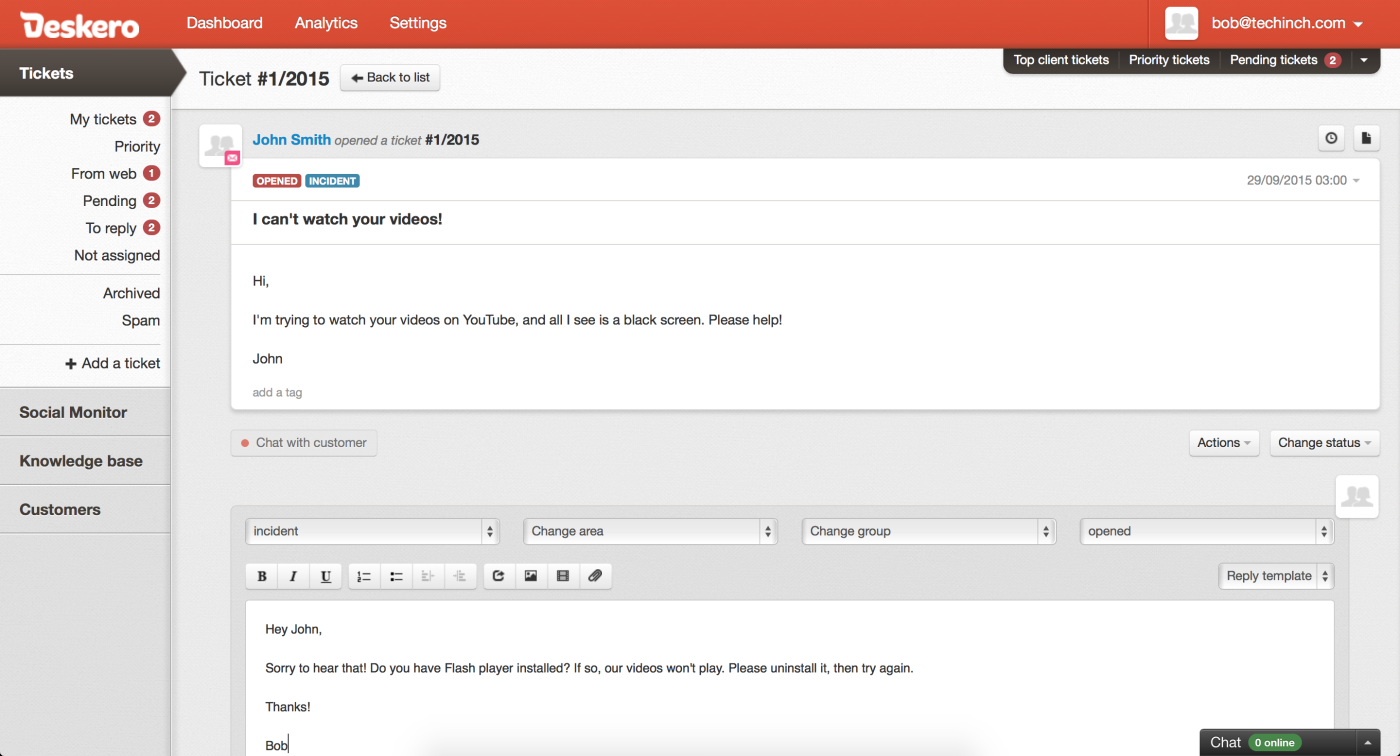
Ever wondered what support requests your competitors are getting—or if your customers are having trouble but don’t ask your company for help? Deskero helps you find out by monitoring social networks right alongside your support requests. It can pull in any support requests you receive from LinkedIn as well as Twitter and Facebook, then monitor each network for mentions of specific keywords. That’ll let you find people who need your tool and see what your competitors are doing, right along with your regular support.
Deskero isn’t just about social support, either. Its support interface helps you stay on top of everything. You can preview entire support email messages and write your replies right in the dashboard, without ever having to jump back and forth between screens. There’s live chat to help customers in real time, mobile apps to help customers on the go, and more. And if you ever need to switch to another customer support app—or want to analyze your support and social data—there’s XML exports to take everything with you.
Deskero Price: Free for 1 user and 1 social account; from $15/month per user Social plan for complete social integration
UserEcho (team inbox, knowledge base, forum, social, chat)
for learning from users
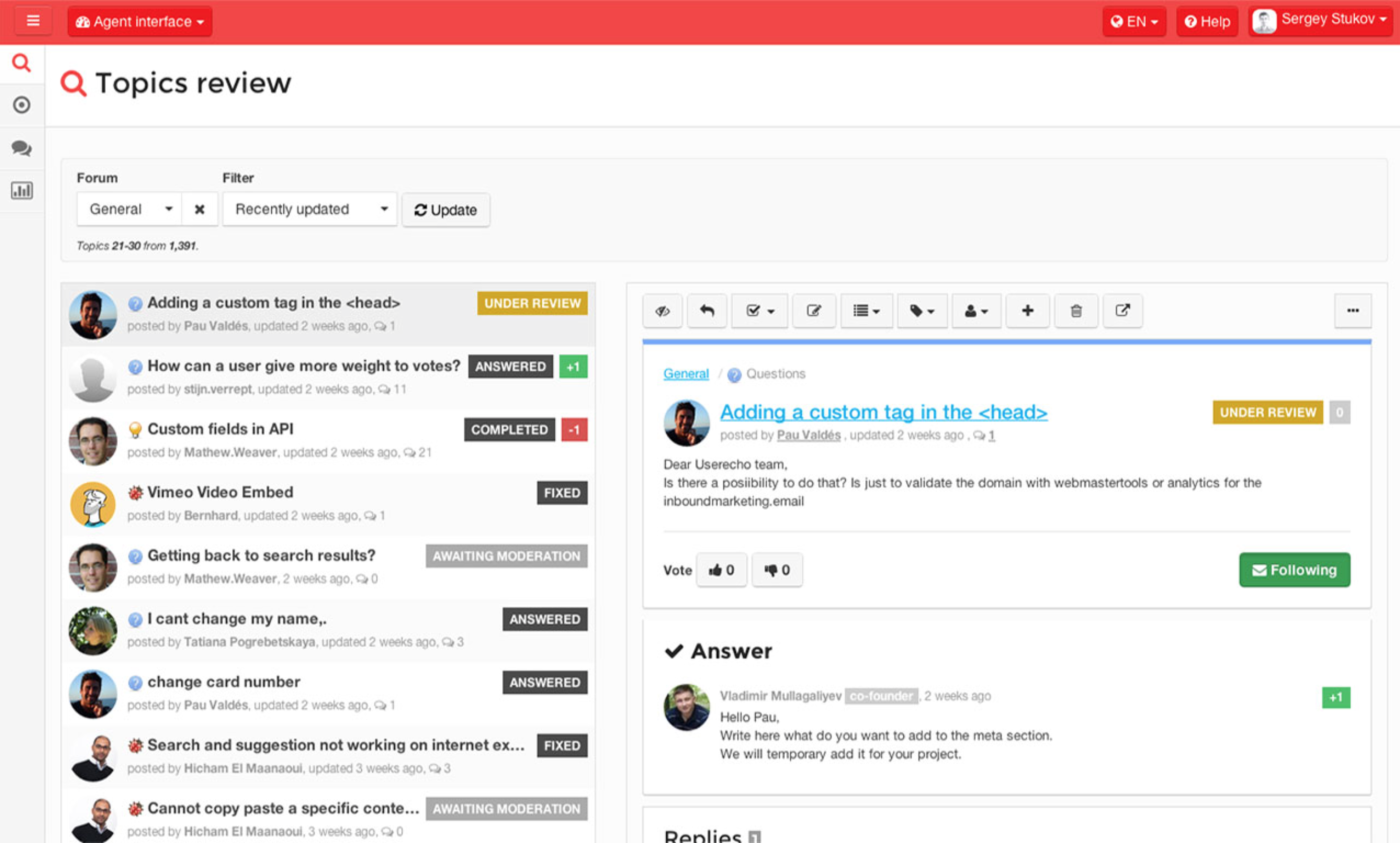
Your customers are telling you what new features they’d like to see and what bugs need fixed every time they send you a support ticket. Whether they directly ask for it, or just mention a problem that bug or lack of feature is causing, each support ticket should be a vote, a reminder that you should get this fixed. UserEcho helps you keep that in focus.
It’s a forum-focused support tool where your users can ask for new features, add comments and thoughts about them, and upvote their favorite ideas. Each new comment and vote will show up in your email support queue, along with the rest of your support emails, so you’ll never forget about the things that are most important to your users. You can solve their problems and answer questions, while prioritizing the most important new features for your development roadmap at the same time.
UserEcho Price: $15/month per user for full features
See UserEcho integrations on Zapier
Pick the Best Customer Support Tool for Your Team
With so many great apps, how can you pick the one that’s best for your needs? If you just need to offer email support or build help documentation for your users, almost any app in this chapter would work fine. But perhaps you want something extra—a special feature to help you offer better support? Here’s some quick tips to help you decide:
Add Custom Features to Your Customer Support Tool
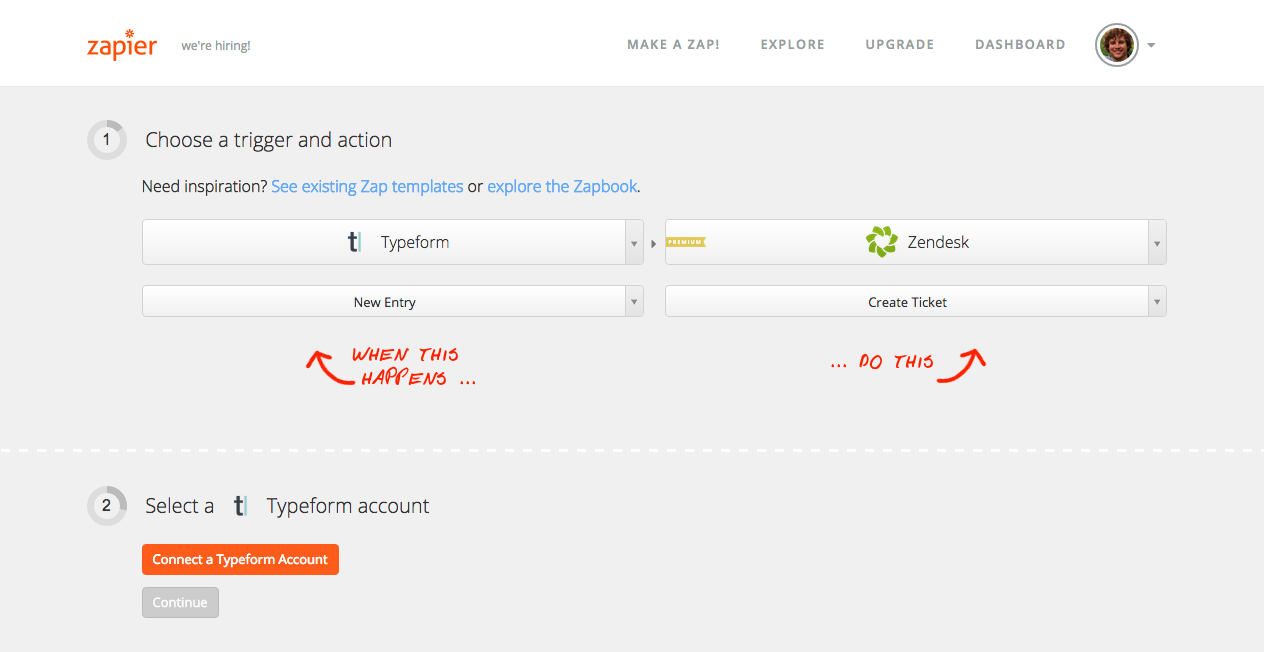
Each of these support tools are dependable, and will each help keep your support inbox under control. But no app is perfect—and no app can include every feature. That’s where Zapier app integrations come in. You can use Zapier to connect your favorite apps and add extra features to your support tool.
Disqus’ customer support team is a great example. With their own support tool, they needed a way to keep track of spam messages that were coming in. Zapier, with a Google Sheets connection, proved to be the solution.
“Zapier is a great tool for getting new workflows up and running with minimal effort,” says Disqus product support manager Daniel Matteson. “It provided us a quick and easy way to get this spam data into a Google sheet, allowing us to start taking bulk action on these reports. We’ve since developed more tools to help on this front, but coming up with that first workflow in Zapier gave us a head start.”
Zapier is a great tool for getting new workflows up and running with minimal effort.
Daniel Matteson, Product Support Manager, Disqus
You’ll need to add your own extras to make a support app perfect for your team’s needs, and Zapier can help you, too. Whether you need to bring in support tickets from other apps, log support data to your CRM, or make sure your team sees the most important tickets—or anything else—there’s a Zap for that.
Here are some popular integrations to help you get started:
Create Tickets from a Form or Another App
Many support tools include their own support form so customers can get in touch with your team from your website. If you already have a web form on your site, though, you might want to keep using it instead. Or, depending on your customer support app, you may want to bring in tickets from social networks, chat, or even other email accounts. These and other Zaps can help you out.
Create Tasks from Tickets
Some tickets take just a quick reply, but others might take hours to solve. You’ll need to loop in the right people, and make sure everyone follows through and closes the ticket. Zapier can automate it by turning your support tickets into bug listings, projects, events, or just a simple task in your to-do list.
Share Tickets with your Team
Need to make sure everyone knows about the latest support tickets? Whether you need to share difficult questions in your team chat, ping your dev team when there’s a technical problem, or make sure your support team sees new messages as soon as they come in, all you’ll need is a Zap that connects your support app to your favorite messaging tool.
Log Support Data
You could just answer your support tickets, make sure your customers are happy, and call it a day. Or, you could keep a detailed log of every support interaction, keeping track of common problems and graphing your support team’s performance. Build your own custom new features with a spreadsheet or database, or help your team celebrate when the support queue is empty—these Zaps will take a bit more creativity, but they’re also incredibly powerful.
Start Trying a New Support Tool Today
Whether you need a simple tool just to answer emails, or a full-featured support center that lets you talk on the phone, live-chat, and turn feature requests into realities, there’s a support app that fits your needs. You just might have to try a few on and see which works best for your team.
So don’t be afraid to experiment—after all, your support team will have to use the app you pick all day, every day for the foreseeable future. Try a few of the apps above that seem to fit your needs best, and see which one sticks. Then, bring over your support documentation and accounts, and dig in. Make your new app feel like home.
With that done, it’s time to get back to providing great customer support, and building better products. That—not your support tool—is what matters anyhow.
Updated Oct 23, 2017 with Freshdesk’s new pricing.
Need Any Technology Assistance? Call Pursho @ 0731-6725516


























